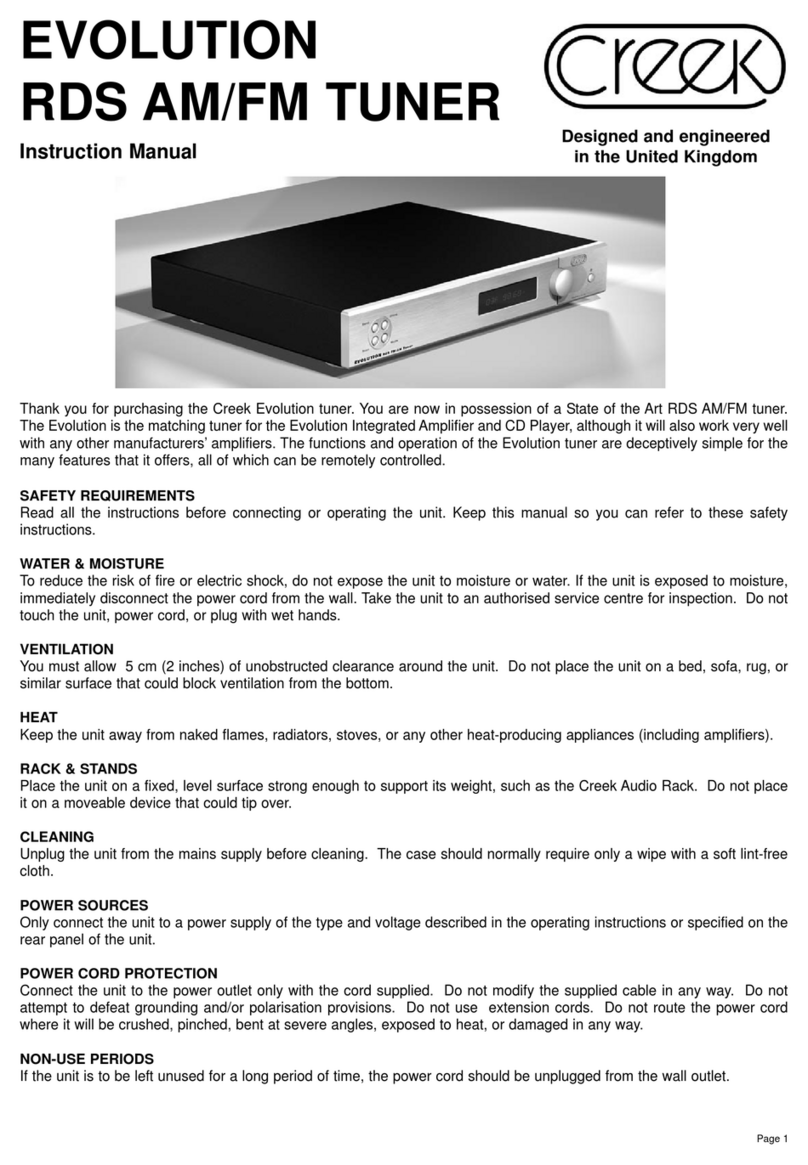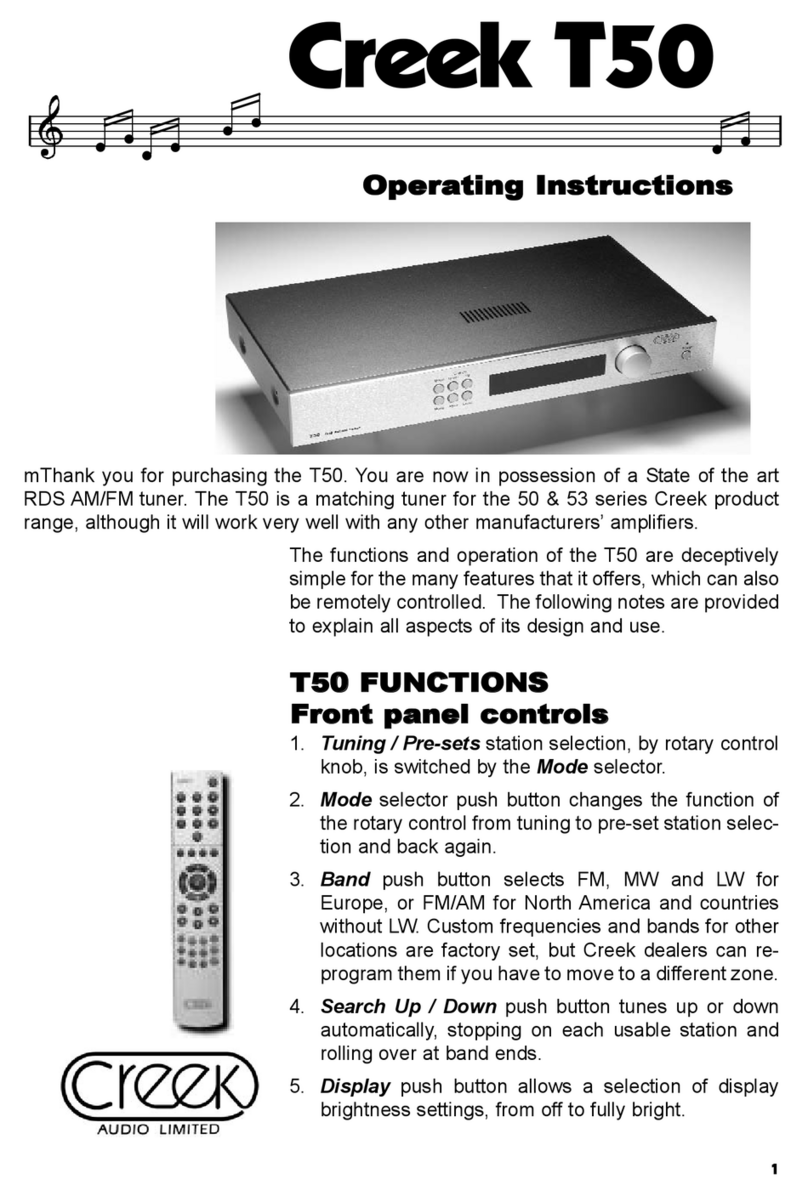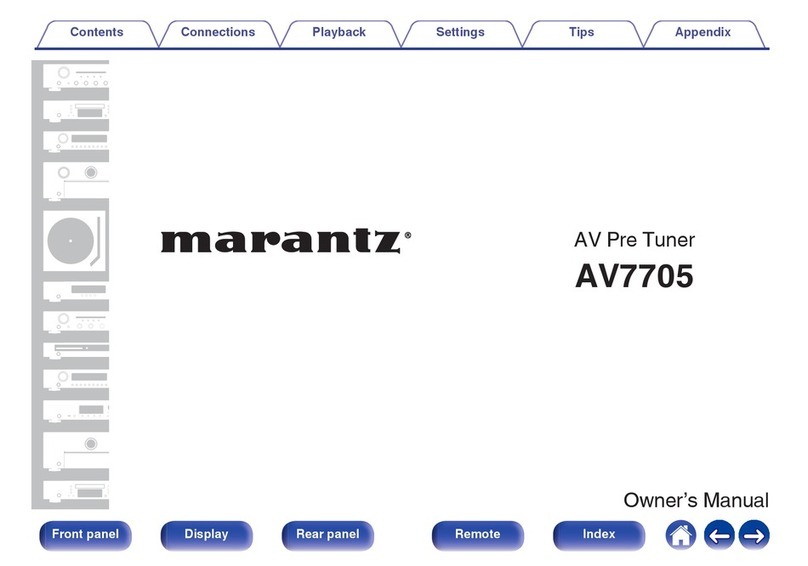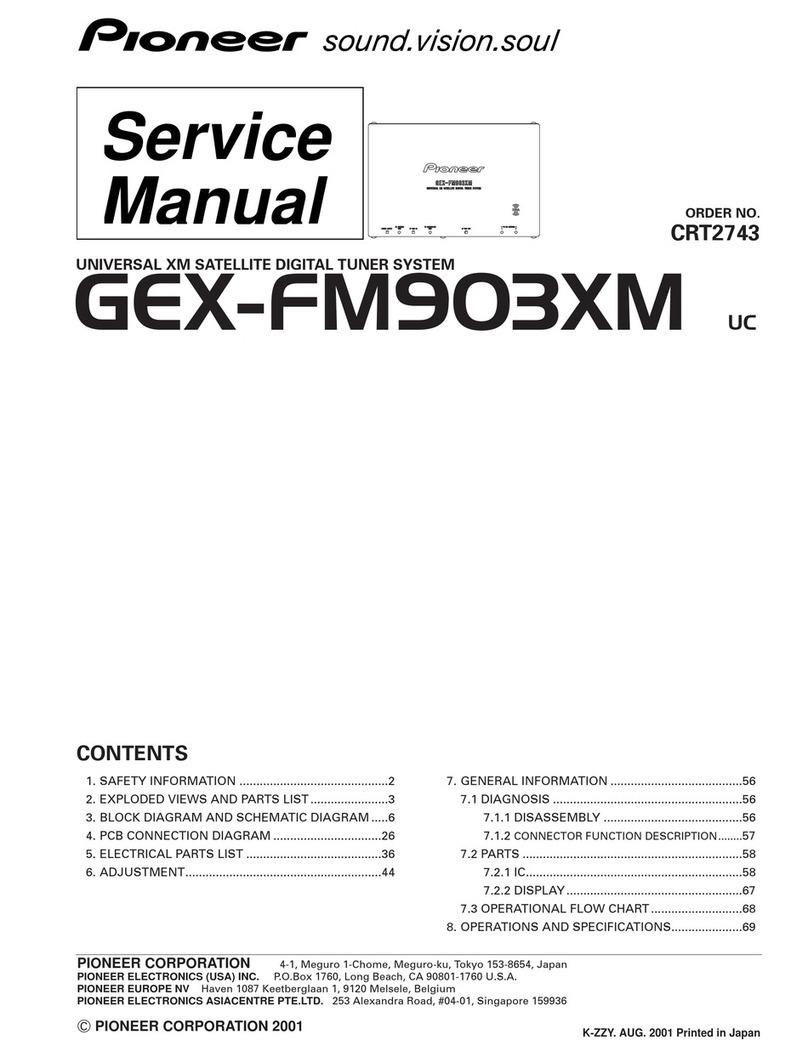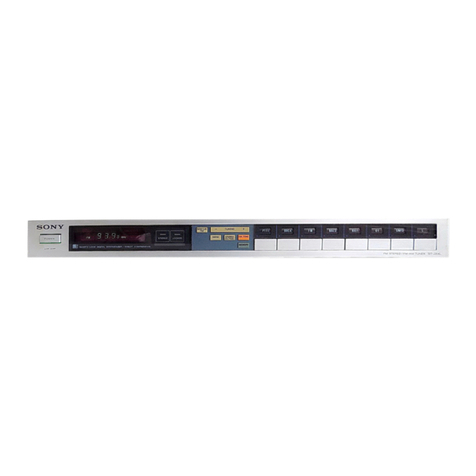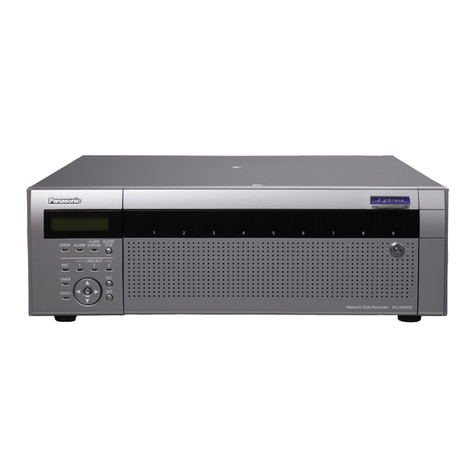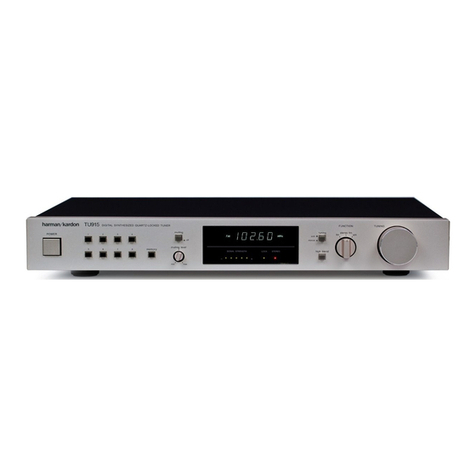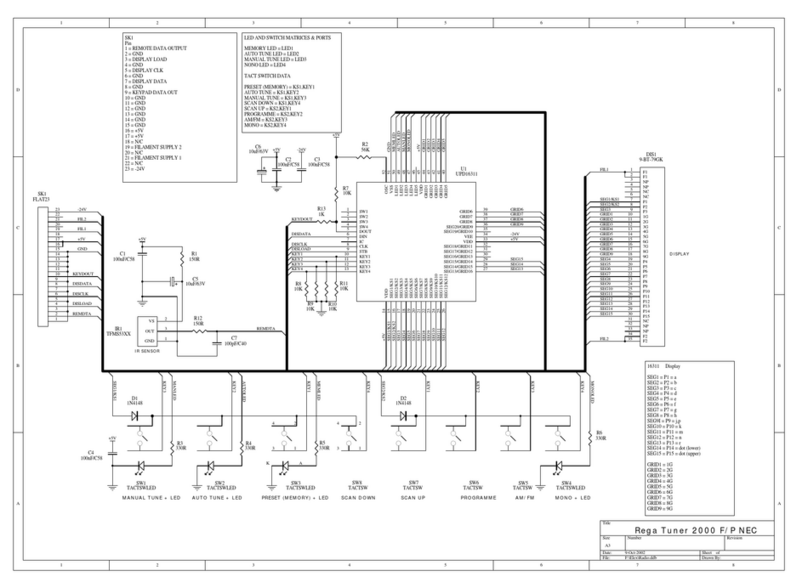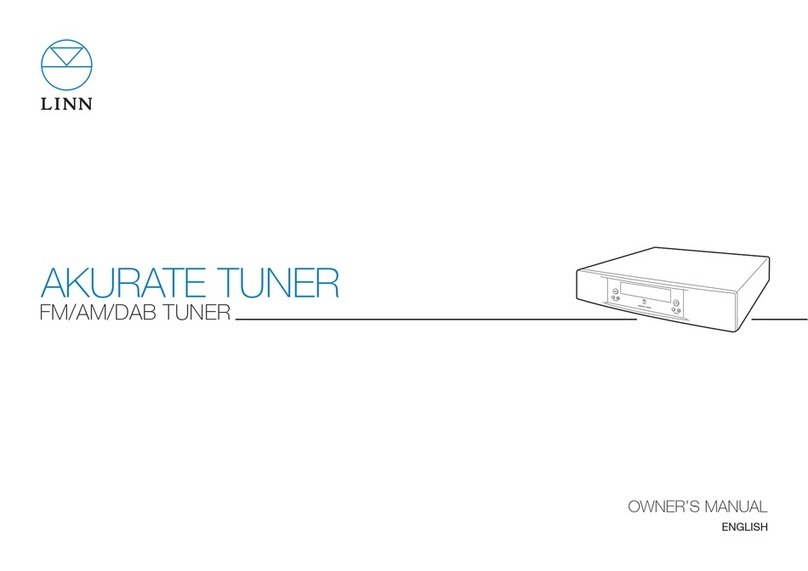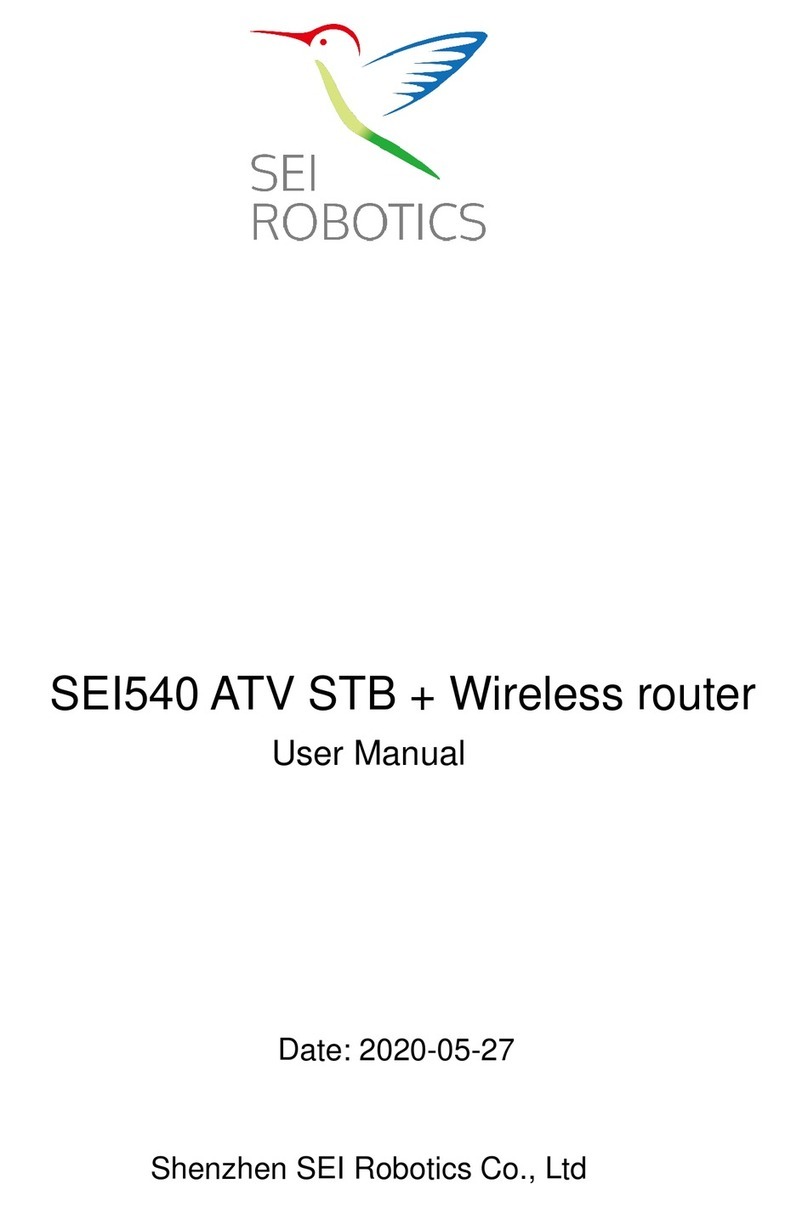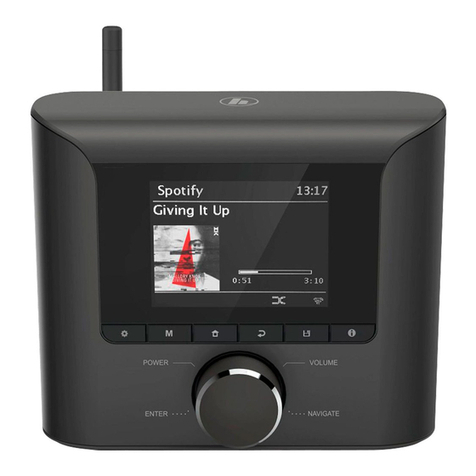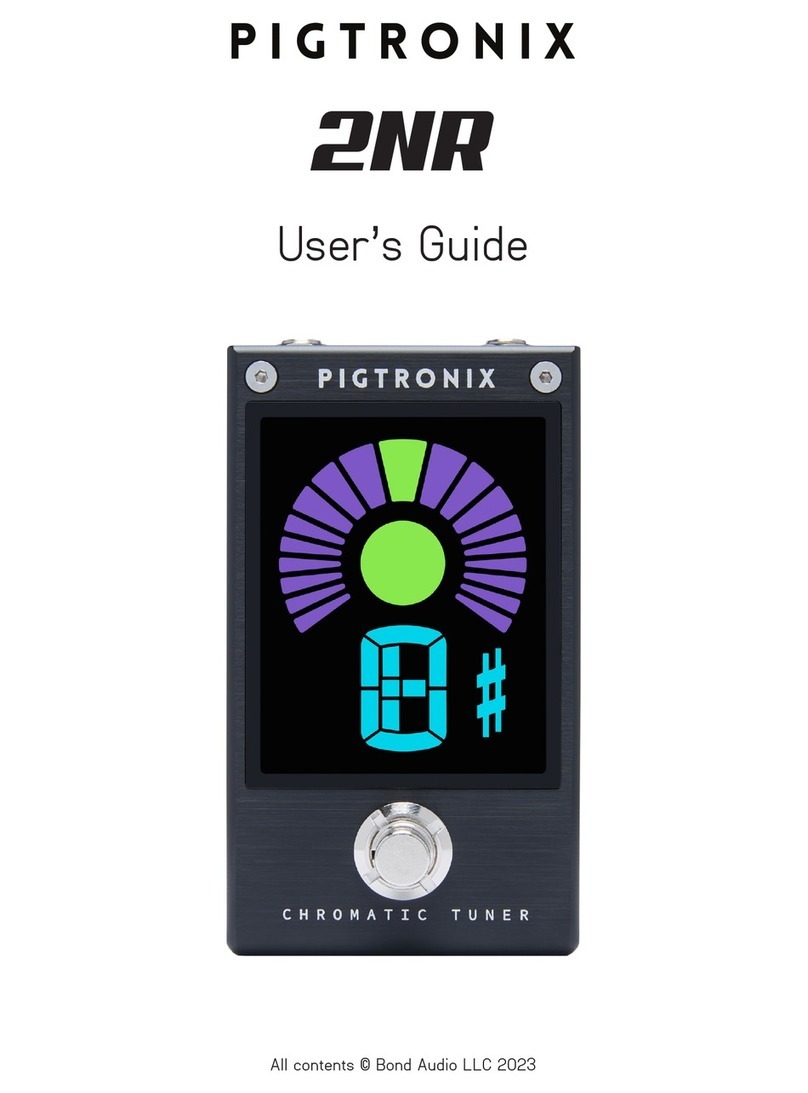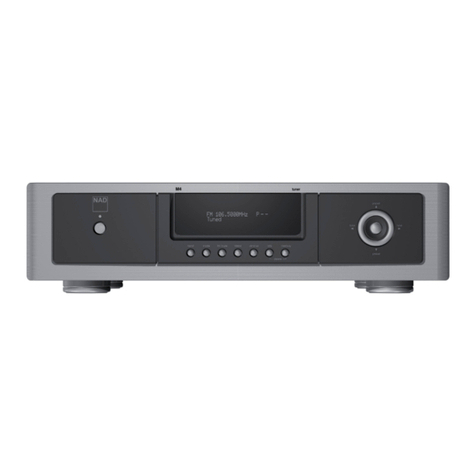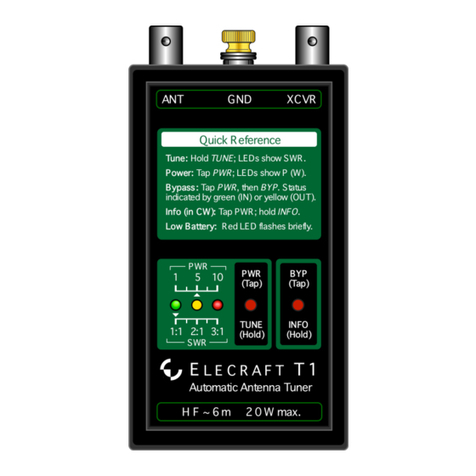Creek Audio T40 User manual

CREEK T40 FM TUNER
GETTING STARTED –Quick Instructions
1. Carefully unpack your T40 from its box. Don’t throw the box and packing away –in the unlikely
event that you may need to return your T40 to the factory for service, the specially designed
packaging will prevent damage in transit.
2. Check that the voltage of your mains electricity supply (house current) is the same as that stated on
the rear panel of the T40. If you are in any doubt please contact your dealer. Permanent damage
to your tuner may be caused if it is connect to a mains supply of the wrong voltage.
3. Attach a mains plug to the end of the 3-core mains supply lead, if one is not already attached. Make
sure that the coloured wires are connected to the correct terminals in the plug. If you are in any
doubt, please consult your dealer. Permanent damage to your tuner (or to you) may be caused if
the plug is incorrectly connected to the cable. Plug in to a convenient socket (receptacle).
4. Connect the audio output of the T40 to the “TUNER” or “RADIO” input of your amplifier. There are
two sets of outputs on the rear panel of the tuner –
¦Two phone (RCA) sockets, left and right, providing low level output (100mV)
¦One 5-pin DIN socket providing medium level stereo output (350mV)
Use whichever is more suitable for your amplifier, or the connecting leads you have. It won’t
matter which you use for now –no damage will occur either to the tuner or to the rest of your
equipment if you use the wrong one, but the sound may be either distorted or too quiet. This is
covered in more detail later in the handbook.
Note: A short lead is provided in the tuner packaging with a DIN plug at each end for
connecting the DIN output on the T40 to the “TUNER” input on our companion amplifiers
CAS4040 and CAS4140.
If stacking the two unis ALWAYS stand the amplifier on top of the tuner, not the other way up. This
is to allow adequate airflow to the heat-sinks at the rear of the amplifier for cooling, and avoids
‘cooking’ the tuner in the amplifier’s heat.
5. Connect an aerial (antenna) to the aerial socket or terminals on the tuner’s rear panel. There are
screw terminals provided for ribbon type cable, and a socket for a 75 ohm co-axial cable. Aerials,
Signals and Noises are covered in more detail later in this handbook, but please note that
however good a Tuner may be, it is only as good as the signal it receives. Good Signals mean Good
Aerials. The CAS3140 will perform better than most tuners using only a cheap indoor aerial, but you
will not benefit from its full capability unless you and your tuner are treated to a good quality aerial
installation.
6. You should now have your CAS3140 connected to an aerial of some kind, a suitable amplifier (and
loudspeakers) and plugged into the mains supply. As a precaution against damage to your
loudspeakers (or your ears) make sure that the Volume control on the amplifier is turned to a low
setting. You can now switch on the amplifier, and select the Tuner or Radio input with the selector
switch.
7. On the CAS3140 make sure that the four push-button switches on the left of the front panel are in
the ‘out’ position. (This is the normal operating position for these switches.)
8. Press in the power switch on the right end of the front panel. The Frequency Display in the centre of
the panel should now have green numbers showing, and the other indicator lights may also be lit.
Don’t worry if they aren’t –that comes next.
9. Turn the Tuning knob on the right of the display until the frequency of a local broadcast programme
is displayed. If you don’t know the frequencies of any local broadcasts, then go to Step 11 below.
10. The Tuning Indicator above the tuning knob should now be lit and, if you turn up the volume control
on the amplifier, you should now be able to hear the broadcast. If so, then move straight to 15
below. If the Tuning Indicator is not lit, then the station you have chosen may not be strong enough,
or you may have selected the frequency incorrectly.
11. Turn the tuning knob slowly to tune along the FM band and you should fid a station which is strong
enough to light the indicator, and be audible. If you are now listening to a broadcast, go to 15 below.

If not, check that all four switches at the left of the front panel are in the ‘out’ position and that the
Input selector of the amplifier is correctly set to the Tuner input, that the TAPE MONITOR switch (if
provided) is in the ‘Source’ or ‘Normal’ position and that the volume is sufficiently loud.
12. Again tune slowly through the band and watch the Frequency Display. You should see that it gets
brighter and dimmer as you tune, and the Tuning indicator (and possibly the Stereo indicator above
the ‘mono’ switch) lights as the display gets brighter. If this is not happening, then check the aerial
and its connections thoroughly, and try again. If the various indicators still fail to respond, go to 14
below.
13. If the Indicators are changing as you tune, but you still cannot hear anything, then carefully check
the connections between the T40 and your amplifier, and that the input to which the T40 is
connected is the one selected by the Input Selector. If all appears correct and there is still silence,
then:
14. If you are still unable to hear any broadcast, call your dealer for help. If you have a knowledgeable
friend to help you, then please ask them to read this Handbook first, as the functions of the controls
on the CAS3140 are very different from most other tuners. There is a detailed description of the
operation of the T40 in the CONTROLS and FUNCTIONS section later in this Handbook.
15. You should now be listening to a radio broadcast through your T40 and you can now get a feel for
some of the various automatic functions it provides. Tune slowly through the FM band, and notice
how the tuner remains silent until the Tuning Indicator lights. Your T40 tuner will normally only let
signals through to the amplifier if they are of adequate audio quality. You will also see that the
brightness of the Frequency Display varies as you tune. The brightness of the display is proportional
to the strength of the received signal –the brighter the display, then the stronger the signal. This
allows you to choose the strongest station to get the best possible reception in areas where there
are more than one station broadcasting the same programme.
So now you can tune your T40 to a station broadcasting some pleasant music, and settle down in a comfortable
chair to read the rest of this Handbook……..
The next section gives a Technical Background to FM broadcasting and reception to help explain the operation of
the features of the T40. If you don’t want to go into this much detail at this stage, then skip straight through to the
section on CONTROLS and FUNCTIONS that follows, which explains the operation of the T40 in detail.
SIGNALS, AERIALS AND NOISES
FM stands for Frequency Modulation, a method of transmitting radio signals. Generally FM is broadcast on VHF
(Very High Frequencies), in the range 88 to 108 MHz (megahertz), although the limits of the band vary from
country to country.
AM stands for Amplitude Modulation, another method of radio transmission, generally used in the LF, MF and HF
bands (Low, Medium and High Frequencies), in the range 150 to 3,000 kHz (kiloHertz). These bands used to be
called Long, Medium and Short Wave, and measured in terms of wavelength in meters, from 2000m to 100m.
Band width is a term which describes a range of frequencies, so that the generally accepted bandwidth of human
hearing is from 20Hz to 20kHz. In audio to transmit audio signals and reproduce them with reasonable fidelity or
quality it is therefore necessary to transmit a sizeable portion of this 20kHz bandwidth, an generally for FM radio
the upper limit is set at about 15kHz as a reasonable compromise between transmitted radio bandwidth and
received audio bandwidth.
Without getting too deeply involved in the technicalities of radio, we can say without too much oversimplification
that, for a given received audio bandwidth there is no difference in quality between AM and FM. However, there is
an enormous difference between the amount of radio bandwidth needed by the two different systems.
With AM, the signal is transmitted by varying or modulating the amplitude of the transmitted radio carrier wave.
The modulation process creates signals on both sides of the carrier frequency, called sidebands, which are equal
to the modulating bandwidth. So to transmit our 15kHz of Audio we need 30kHz of Radio, and to transmit BBC
Radio 4 on 200kHz Long Wave we would use a portion of the band from 170kHz to 230kHz, or practically the
whole band! For this reason the transmitted audio bandwidth on broadcast AM is significantly restricted to well
below 5kHz or so, and this is why AM is thought to be lo-fi, not because AM is inherently an inferior transmission
medium, but because AM broadcasts are transmitted that way, so that enough stations can have a fair share of
the available bandwidth.
With FM, the signals are transmitted by varying or deviating the carrier frequency to either side. The amplitude of
the carrier remains constant, and it is its frequency that changes to carry the audio. The bandwidth used to carry

an FM signal carrying our 15kHz of audio is dramatically greater than for AM, because the maximum deviation of
the carrier to either side of its normal frequency is proportional to the maximum amplitude of the audio being
transmitted, so the limitation on radio bandwidth is imposed not by the audio frequency range but by its dynamic
range. For good fidelity of reproduction, dynamic range Is an equally important factor to bandwidth, and our FM
system will need something like 300kHz of radio bandwidth to transmit our 15kHz audio signals, or equivalent to
nearly one third of the Medium Waveband. To use FM for good quality broadcasting it is therefore necessary to
transmit at frequencies high enough to give enough bandwidth for each channel, hence VHF.
Why, then, is FM used? Well, it has many inherent advantages for transmission of high quality music signals.
Most interference and static tends to be AM by nature, and so an FM receiver can be made to reject this
unwanted AM, and be relatively interference-free. The FM transmitter runs at constant power, and can be
designed to work more efficiently. It is possible to design an FM receiver which detects if it is off-tune, and applies
correction automatically to keep locked to the station being received. This is called Automatic Frequency Control
(AFC). Also F receivers exhibit a phenomenon called ‘capture effect’. If two stations transmit on closely adjacent
frequencies, instead of the receiver detecting both together it will be ‘captured’ by the stronger signal, allowing
clean reception. The ration between the strengths of the two signals need not be very great for this effect to work,
and with the added benefit that VHS signals travel only short distances (the line of sight, more or less) this allows
many stations to share the same channels without interfering with one another. The most important benefit of FM
for Hi-Fi users is that of greatly improved Signal-To-Noise ratio which can be obtained. Again, without getting too
deeply into the technicalities, to transmit information (and speech or music are a form of information) there is a
possible trade-off between three parameters, being rate of information transfer, signal-to-noise, and transmission
bandwidth. In the case of broadcast radio, the rate of information relates to the received audio bandwidth –the
higher the audio frequency we wish to receive, the faster must the modulation take place at the transmitter. To
achieve this fast rate of information transfer with FM we have to use a great chunk of bandwidth, anyway which
means that we can achieve a great benefit in improvement of signal-to-noise performance.
With AM, the weaker the received signal, the weaker also is the recovered audio –eventually the signals just fade
away into nothingness. With FM, however, the recovered audio is independent (to a point) of the received carrier
strength. What happens is that the audio gets noisier with weak signals, eventually disappearing into the noise.
An AM receiver receiving no signals is silent. An FM set under the same conditions produces nothing but (lots of)
noise. Therefore if we make sure that the signal reaching our FM tuner is as big as possible, then we will ensure
that we are receiving as noise-free (and interference-free) a signal as possible, and therefore obtaining the Hi-est
possible Fi. That is why a good aerial system is vital to good Hi-Fi FM reception.
The importance is greatly increased by Stereo. Returning to our simple information theory for a moment, you can
probably see that a stereo signal must contain more information than a mono signal of the same strength. In fact
probably twice as much, since there are now two different signals where before there was only one. Since they
are occupying the same bit of transmission bandwidth as before, and we are now passing information through it at
a faster rate, something in our trade-off must get worse, and it does. In return for our increased information we
lose signal-to-noise performance –the recovered audio gets noisier.
In fact our surmise that two channels in the space of one will mean a factor of two worsening in noise
performance is wildly wrong. Because of the need to make stereo signals compatible with (receivable n) mono
receivers, the extra information to transmit stereo is sent in a clever way, modulated onto a sub-carrier above the
15kHz of mono audio. The combination of this, plus the fact that the mathematics of stereo versus bandwidth are
somewhat more complicated than our surmising would indicate, actually makes for a dramatic increase in noise,
of about 20dB or a factor of 10. In other words, to receive a stereo version of a mono signal requires ten times
more signal at the aerial socket of the tuner to get the same audible noise level. For stereo reception a good
aerial is not a luxury, it is an essential.
Since we have designed the T40 to appeal to those who do not have unlimited resources to spend on their Hi-Fi,
but nevertheless enjoy listening to the highest quality sound possible, we have incorporated several unusual
features to minimise the effects of weak signals. Even so, you will greatly improve your listening pleasure if you
have a good aerial to pull in the signals. Your dealer can advise you on what is necessary for your location, since
VHF reception is variable from place to place. There are also specialist companies who are experts in aerial
installation, and will advise and estimate fairly on your particular needs.
In general if you live within a few Kms of the transmitters then a simple indoor dipole will be fine. Out to about
25Km a 3 or 4-element loft aerial will also be perfectly adequate. Beyond this range it is impossible to generalise.
If you live on high ground, with nothing much between you and the transmitter, then an indoor aerial can give
good results from 80Kms away. Conversely a gasometer or similar large steel structure can completely mask a
transmitter only 3Kms away.
If you live near an airport, or under the path of a busy air-lane then you may experience ‘aircraft flutter’ which is a
rapid fluctuation in signal strength due to reflections of the radio signals from aircraft, and sounds like a fluttering
noise. In severe cases you may see the stereo indicator flashing as the signal varies. It may be possible to point
your aerial at a different transmitter in another direction to overcome this problem, but if there is only one source

of the particular station you wish to hear then it will be necessary to resort to an array aerial of stacked dipoles to
reduce the reception of the reflected signals.
At certain times of the year, and in particular weather conditions, you may hear whistling or twittering noises,
known as ‘birdies’. This is due to interference from other stations on frequencies very close to that to which you
are trying to listen. Normally this doesn’t occur because stations on the same channel are spaced geographically
far apart by international agreement, but freak conditions called a ‘lift’ do happen, particularly in anticyclonic
weather, when radio signals propagate far greater distances than normal and well beyond the usual operating
range. When this happens there is little you can do about it, unless you have your aerial on a rotator, which will
allow you to ‘null out’ the offending signal by using the directional properties of the aerial to pick out one particular
station. Obviously this won’t work if both transmitters lie in the same direction, and in such cases you may have to
switch to mono (which will reduce the effect dramatically) and wait for the weather to change. The T40
incorporates features to minimise the effect of such conditions, so you are unlikely to be unable to achieve
satisfactory stereo except in really extreme conditions.
The spread of the home computer has given rise to a new form of interference recently, which is identifiable by a
sort of electronic ‘whistling’ noise changing in pitch. If you suffer from this then the source is very local –within a
few metres –and can generally be overcome by r-siting of the aerial, and routing the cable away from the
offending computer. Causing excessive interference in this way is illegal in most countries, although taking legal
action against one’s neighbours is not usually a pursuit undertaken lightly, If you cannot eliminate the problem by
aerial positioning then perhaps the offending computer’s owner can be persuaded to carry out some supression of
his equipment.
Other possible problems can be breakthrough from very local transmitters in (for example) police cars or from
Citizens Band Radio. In the case of public services there is generally a technical advisory service which can help
sort out the problem, by fitting special-purpose filters in the aerial lead to reject the offending signals. CB can also
be reduced in this way, but generally the local CB club are only too willing to help solve a genuine problem. The
few irresponsible CB users who are unconcerned about causing interference deserve whatever weight of the law
can be caused to fall upon them, and in such cases the Government agency responsible for Radio Regulations
will identify and stop the offending equipment from further operation. If you live in a weak signal area and are
using an aerial preamplifier to boost reception, then your equipment will be particularly prone to interference from
mobile transmitters, as preamplifiers are notorious for suffering from breakthrough of this type. Ones that don’t are
complex and consequently expensive, so if you do wish to purchase such a booster, make sure that it rejects
unwanted signals as well as improving wanted ones.
CONTROLS and FUNCTIONS
We have designed the T40 to have the performance of laboratory equipment without the penalty of laboratory
looks or complexity of use.
Our philosophy is to design products with facilities which benefit the user rather than the reviewer, and which are
different from those of other manufacturers because we try to think our designs through from the beginning, rather
than trying to copy all the unnecessary functions which are normally provided to fill up space on front panels.
We are sure that the functions we have incorporated in this tuner will make it very easy to use, so that you will
constantly obtain the high performance of which it is capable.
A. AUTOMATIC FUNCTIONS
Switch-on Stabilisation Delay
When the T40 is switched on, a delay circuit waits for the internal control functions to stabilise before operation
will start. This normally takes between 15 and 20 seconds. A further 2 seconds delay then occurs before the AFC
system is enabled, ensuring that the tuner will return to the last station tuned before switching off.
Muting, Mono/Stereo, Blend and Tuning Indicator
Tuning accuracy is very important for high fidelity reception of FM broadcasts. The T40 uses specially developed
integrated circuits to allow exceptional tuning accuracy with great simplicity for the user. The same circuits also
control the operation of the entire tuner to ensure that the best possible quality of audio is obtained at all times,
automatically.
The Tuning Indicator, Muting, Blend and Stereo/Mono functions are operated by control signals derived from Ics
from three parameters of the received signal –Detuning, signal/Noise Ration and Signal Strength.
The Stereo/Mono and Muting functions are not simple on/off switching functions, but are progressive, proportional
and carefully balanced against the three control parameters to ensure optimum listening performance but with
extreme ease of use.

The control signals are monitored continuously, and are derived and perform control as follows:
Signal-to-Noise information is obtained by extracting a DC signal proportional to the non-audio content of the
received and demodulated signal. The signals present above 75kHz are a function of the noise content of the
demodulator output, while those below 10Hz are a function of inter-modulation and cross modulation products
between adjacent channels. The subsonic content is also used to trigger the blend circuits in the presence of
aircraft flutter, momentarily forcing the tuner to mono to reduce the irritation of this interference.
Signal Strength is extracted from the IF limiter, and is linearised to give control signal proportional to the RF at
the aerial socket over a range greater than 80dB. This control signal is also used to operate the Automatic Gain
Control (AGC) in the RF tuner head to prevent overloading in the presence of very strong input signals, and a
further control signal is derived to ‘gate’ (or switch) the AGC operation, described below.
The brightness of the frequency display is controlled by a derivative of the signal Strength monitor to give a clear
indication of relative signal strength to the user.
Detuning is a measure of the amount that the tuner is off-station. It is derived from the Automatic Frequency
Control (AFC) signals, with further processing to obtain a linear control voltage proportional to the magnitude of
the difference between the required station and the actual tuning point of the tuner. The Detuning monitor is also
used to disable the AFC action between stations, described in more detail below.
These various control signals are then combined to provide progressive control of the muting circuits and the
stereo decoder. The operation of the system as a whole is best understood by examining in detail what happens
as the tuner is tuned from an empty part of the band onto a strong station…
When the tuner is completely off-tune, and receiving no signals at all, then the Signal Strength monitor is at zero,
the detuning monitor is at zero (cannot be de-tuned from nothing) and the signal/noise monitor shows zero (no
signal –all noise). Combining thse signals on a ‘voting’ basis gives two out of the three voting for no signal worthy
of any attention, and the audio output is held firmly muted. The stereo decoder is also forced to mono, but as
there is no pilot tone signal for it to lock onto it holds itself in mono, anyway.
As we tune towards a station the Signal Strength monitor starts to rise, as does the Signal/Noise monitor (since
the supersonic content of the recovered audio falls rapidly as a station is approached). However the subsonic
content of the audio is now very high (due to the amplitude modulation products of the FM signal operating in the
non-linear ‘skirt’ region of the IF filters) and the Detuning monitor shows that we are strongly off-tune, and so the
audio is still held firmly muted by a two-against-one vote as before.
As we now tune more into the range of the IF filters, within 150kHz of the centre of the desired station (75kHz in
Narrow mode) the Signal Strength monitor reaches its maximum, and (if the signal is strong enough) operates
the AGC in the front-end. At this point the Stereo Decoder is released from mono, to allow it to lock onto a pilot
tone if one is present, thereby lighting the Stereo Indicator. The proportional Stereo/Mono Blend is set by the
(now stable) Signal Strength monitor to give the ‘amount’ of stereo available once the mute is finally released.
This is described in ore detail below.
If AFC is switched On it is also now released to take control of tuning, accelerating the tuner circuits rapidly into
the centre of the station frequency. At the exact centre of the desired station the Detuning monitor returns to zero,
and this un-mutes the audio output fully, and lights the Tuning indicator.
If the AFC is Off, then the muting is progressively released as the station centre is approached, lighting the
Tuning indicator at the exact centre frequency when the mute is fully open.
The monitor circuits continue to operate, so that if a burst of noise or interference is detected the mute will close
briefly to prevent these unwanted signals reaching the amplifier.
The effect of the progressive muting function is to make the tuning knob seem to operate as a ‘clickless’ rotary
switch. As the knob is turned through each station the tuner un-mutes at the point where the station is perfectly
tuned, lighting the Tuning Indicator. This ‘switch’ effect is much more pronounced with the AFC switched Off. With
AFC operating the T40 tunes rather like an AM radio –the station is apparently loudest at the point of perfect
tuning, and gets quieter as you tune away to either side of this point. This makes it easy for those users unfamiliar
with FM tuners to achieve the perfect tuning essential to obtain full FM performance. It is quite possible to tune a
station entirely by ear, although the Tuning Indicator lights exactly at the centre point so it may be a little silly not
to use it!
More about Mono/Stereo and Blend
As mentioned earlier, the effect of going from mono to stereo is to require 20dB more RF signal to achieve the
same audio signal-to-noise ratio. The T40 incorporates a progressive changeover stereo decoder, which is
controlled by the Signal Strength and Signal/Noise monitor signals. The decoder operates by mixing or blending

the Left and Right stereo signals to give partial mono over a 20dB range of signal strength. The effect of this is to
maintain an almost constant audio signal/noise ratio during the transition from full Mono to full Stereo. Even partial
Mono is still very pleasing, certainly much more listenable than full, but 20dB noisier, Stereo. When the decoder is
in the fully Mono condition the Stereo Indicator is extinguished, although the pilot tone oscillator is left running to
maintain stability. This ‘Monoing’ can happen very quickly and briefly during flutter conditions, effectively masking
this irritating interference.
The Blend Function is also controlled by the Signal/Noise monitor, so that in the presence of Adjacent Channel
Interference (birdies) a degree of blend is introduced regardless of signal strength, reducing the audibility of this
interference considerably.
The decoder’s oscillator operates at 76kHz, and is divided down to 38kHz to obtain the stereo sub-carrier, phase-
locked to the 19kHz pilot tone. This feature makes the T40 immune to birdie-like interference problems which
result from other transmitted signals such s for the German VWF/ARI traffic information system, which operates
on a 56kHz sub-carrier and is used in many European countries.
More about AGC and AFC
The T40 incorporates two additional features using its other signal monitors to enhance performance –Gated
AGC and Detuning-limited AFC.
In some areas there are one or two very powerful local transmitters which can prevent reception of weaker
stations adjacent to them in the FM band by dominating the front-end AGC. Normally the AGC signals are derived
from the first IF amplifiers, which look at a10.7MHz wide ‘window’ onto the band. Obviously, one very strong
station within this wide window will cause the AGC to reduce the sensitivity of the front end, preventing it from
detecting any weaker signals in the same window. In the T40 an extra monitor signal is obtained from the second
IF circuits, which look through a window only 300kHz wide (150kHz in Narrow mode).
If this second signal indicates that the AGC is reducing front-end gain due to a strong station outside the second
IF window, and therefore not of interest, the AGC circuits are turned off, or ‘gates’. This allows reception of any
weaker transmitters being masked by the presence of one dominant station elsewhere in the band.
Normal AFC control can also sometimes be self-defeating, since the AFC system must be a compromise between
holding on firmly to the tuned station, and allowing the tuner to be deliberately moved to another one when
wished. The two extremes of this trade-off either allow the tuner to drift away from the desired station too easily,
or alternatively hang on to it permanently, preventing selection of a different station without first disabling the
(‘grim death’) AFC.
In the T40 the AFC is itself controlled by the detuning monitor, so that we can achieve very firm AFC once the
desired station is tuned, but while actually tuning along the band there is no AFC action at all. The prevents the
tuner from ‘flipping’ from one strong station to the next as it is tuned, missing out any weaker signals in between.
This Detuning-limited AFC allows the T40 to eliminate the compromise and use both extremes when
appropriate, ensuring both easy tuning and then very stable locking to the required station.
Frequency Display
The green, digital frequency display indicates the frequency to which the tuner is actually tuned and is calibrated
in MHz to a resolution of 100kHz.
Although the display cannot therefore show the correct frequency for one or two European broadcast stations
which do not transmit on exact multiples of 100kHz (e.g. 95.125MHz), the tuning system in your T40 will ensure
that the tuner locks accurately to the centre of any channel to which it is tuned.
Finally if you do have any queries about the operation of the T40 which are not covered in this Handbook, or you
wish to clarify something that is, then please contact your dealer, Creek Audio Systems or our overseas agents.
B. FRONT PANEL CONTROLS
1. Wide/Narrow
This switch changes the bandwidth of the IF amplifiers. In simple terms this means that the tuner is
selecting a narrower ‘window’ of the FM band to extract signals. As discussed in the Aerials,
Signals and Noises section, we need a window of about 300kHz wide to transmit and receive
15kHz of audio with adequately high fidelity, and a 300kHz window is used by the T40 with this
switch in the normal ‘WIDE’ position.
In normal conditions this bandwidth is perfect, because FM transmitters are cunningly placed within
the band (by international agreement) so that they are at least 300kHz apart in any particular area.
This assumes that the normal range of a VHF transmitter is restricted to somewhat less than
100Km. However in occasional freak weather conditions (called a ‘lift’) the propagation of VHF

signals can far exceed their normal range, and can spill over into adjacent transmitter’s service
areas. This causes Adjacent Channel Interference, which produces whistling or ‘twittering’ noises at
the receiver (‘birdies’), and can be very irritating. The problem is much increased when listening to
stereo signals, due to the signal/noise and bandwidth requirements for stereo being so much greater
than for mono.
To overcome this problem the T40 allows you to reduce the receiver ‘window’ to 150kHz by pressing
in the Wide/Narrow switch, which greatly reduces ACI and allows satisfactory reception in
otherwise impossible conditions. Narrow operation will increase distortion of the audio signal quite
significantly, but the ear is much more tolerant of this sort of signal degradation than it is of the high
pitched whistles that ACI normally produces.
The Narrow position can be used if you wish to take advantage of the exceptional sensitivity of the
T40 to receive stations from well outside their normal service area, when ACI would normally
prevent this. The automatic functions in the T40 will try to make any signals as pleasant to listen to
as possible in all situations, but the Wide/Narrow facility will help considerably if you are trying to
receive signals at the limits of the capability of the VHF/FM brodcasting.
2. DX Local
This switch changes the operating conditions of the automatic functions in the T40 to allow reception
of much weaker signals than are normally useable for high fidelity listening. In the LOCAL position,
although the sensitivity of the tuner remains unchanged, the thresholds of all the monitor signals are
moved, so that only the stronger available stations signals are able to open the muting and become
audible. In this position all the automatic functions are optimised for maximum sound quality.
In the DX position the muting position is held just at the point of release, so that a very quiet
background noise can be heard between stations while tuning. In this position the automatic
functions are optimised for the reception of weak signals with the maximum achievable sound
quality –with very distant stations that achievement may be only just acceptable, but in all cases the
T40 will do its best to extract as much as possible for you to hear the required station satisfactorily.
3. Mono/Stereo
This switch allows you to force the stereo decoder into Full Mono operation, regardless of the
programme being received. This is sometimes necessary in freak weather conditions to eliminate
‘birdies’ (adjacent channel interference) if the automatic functions in the T40 are able to cope.
In normal use of your tuner, operation of the Local/DX switch should be adequate to obtain noise-
free listening from any desired station.
4. AFC
This switch allows you to disable completely the operation of the Automatic Frequency Control
circuits in the T40. This can help when tuning to exceptionally weak stations. Remember that,
without AFC, there is nothing to prevent the tuner from drifting away from the required station.
As mentioned in the Quick Instructions at the beginning of this Handbook, the T40 is designed to be used with the
four function switches in the normally ‘out’ position, and you will find that you need to over-ride your tuner’s
automatic functions very rarely, if at all.

BRIEF SPECIFICATION
??Tuning Range 88-108 MHz
??Input Signal for –3dB limiting 0.7uV
??Mono
(S+N)/N=26dB 0.9uV
=46dB 2.2uV
??Stereo (channel separation 32dB)
(S+N)/N=46dB 20uV
??Input signal to light stereo LED 5uV
For 40dB separation 20uV
??Stereo channel separation for Vin ›100uV 46dB
??AM Suppression at Vin = 1mV › 50dB
??Total Harmonic Distortion with input signal +/-75kHz ‹ 0.2%
??Audio bandwidth (-1dB) 25Hz –15kHz
??Pilot tone suppression › 64dB
??Aerial input 300 ohm balanced and 75 ohm, unbalanced
??Size 420 x 165 x 64mm –16 ½ x 6 ½ x 2 ½”
??Weight 3.3 kg –7 lbs
Table of contents
Other Creek Audio Tuner manuals

